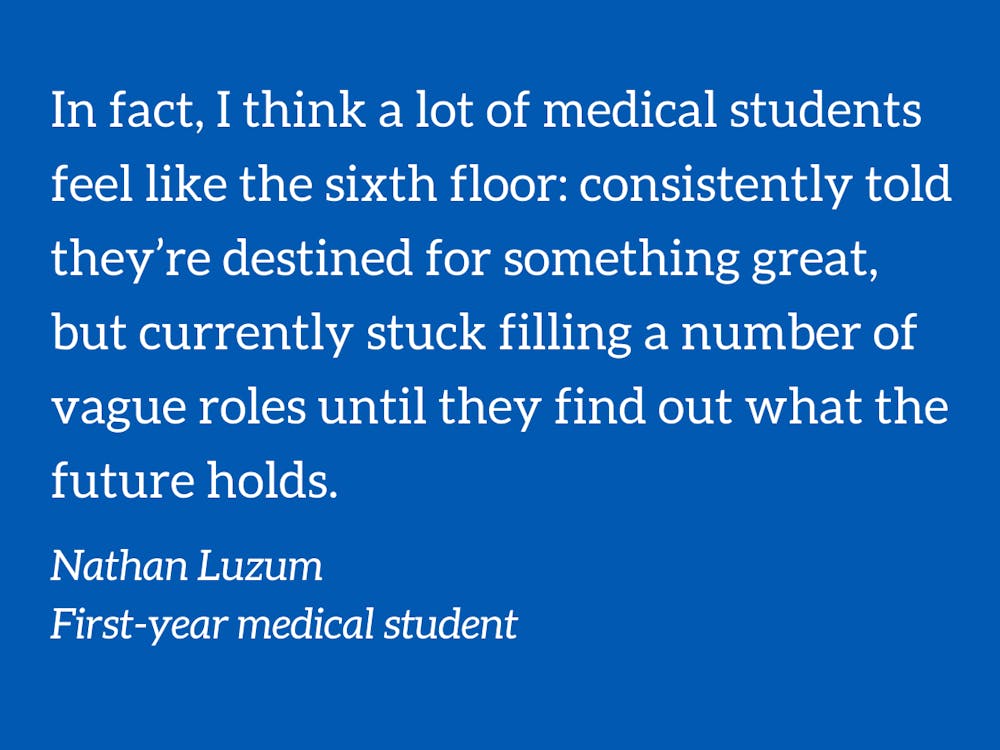The sixth floor of Duke’s medical school is one of my favorite places to study. It’s an expansive space with a smattering of chairs, tables and even a piano, graced with a high ceiling above and a stunning view of the campus beneath.
Rumor has it that when the Mary Duke Biddle Trent Semans Center for Health Education—or TSCHE, more manageably—opened in 2013, the sixth floor was built as swing space to accommodate whatever the future of medicine has to hold. I’m not sure whether this is actually true, or if the construction company accidentally built the school 20 feet too tall and this was the best explanation people could come up with. But I like the symbolism, so we’ll go with it.
While the other floors of the building have a clear purpose, the sixth floor’s is remarkably nebulous. The presumption is that it will one day serve a specific function, but for now, the top floor’s purposes are varied: a place to frantically study all the limb muscles the day before an anatomy practical, to serve as event space for a conference or simply to gaze down at the meandering crossroads connecting Duke’s campus.
Every time I study on the sixth floor, I experience the clumsy confluence of past and future. My eyes frequently wander out the window and to the Chapel, scanning the buildings and paths inextricably tied to random memories of being an undergrad at Duke. The staircase that would serve as a shortcut when I was rushing to my research lab still has puddles of water after a big storm, and the LSRC quad where I’d toss Frisbees with friends who left campus long ago still has grass that looks just as green. Finally, after a minute of glassy-eyed staring, I return to the present.
Truth be told, I try to avoid visiting West Campus proper as much as possible. Whenever I do, I come away with a sense of profound awkwardness, a feeling that my time has passed and that I don’t belong there anymore. When the Chapel bells toll at 5 p.m., it’s no longer for me. I see places where I frequently spent time with other people, and then I remember those people aren’t here anymore. They’re hundreds or thousands of miles away, and I’ve been putting off catching up with them for far too long.
Perhaps most concerningly, sometimes when spending too much time around West Campus, I start sounding like an old man lecturing his grandchildren. No one cares that I can remember a time when Sazon was just an Il Forno sandwich bar, or that Joe Van Gogh was once an on-campus coffeeshop (long story). With the undergrad student body turning over roughly every four years, institutional memory becomes short; the students are recognizable, but their faces aren’t.
It’s only appropriate that these thoughts about bygone days on Duke’s campus also come to me on the sixth floor of the medical school, a space that’s oriented to medicine’s future but anchored to its past and present in the forms of the floors supporting it. As much as I consider my future in medicine, I feel myself pulled back into a different world when looking out on campus, trapped in some unseemly purgatory between past and future. But as I spend more time in medical school, I expect my emotional ties to undergrad spaces will lessen.
In fact, I think a lot of medical students feel like the sixth floor: consistently told they’re destined for something great, but currently stuck filling a number of vague roles until they find out what the future holds. One week of lectures can bring topics as varied as the leg muscles, cancer genomics and mitochondria—and with such widespread topics, sometimes it’s difficult to envision which aspects will frequently appear in our clinical practice.
At the same time, however, medical school is also about constructing a broad foundation—the lower floors to buttress our sixth floor, if you will—to underpin a space that will become filled with specialized knowledge during residency, fellowship and beyond. It’s a foundation whose details we won’t remember perfectly or effortlessly, but one we’ll return to as our futures in the medical world crystallize and gain more definite form.
But for now, I’ll happily sit on the sixth floor as we both await finding our place in the future of medicine.
Nathan Luzum is a first-year medical student. His column typically runs on alternate Thursdays.
Get The Chronicle straight to your inbox
Signup for our weekly newsletter. Cancel at any time.

